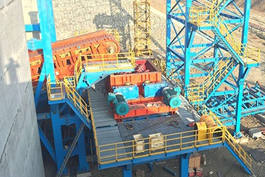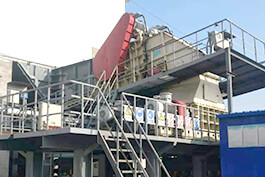Introduction
The Feeder Breaker consists of two parts. The first part is the conveying section, which is the chain conveyor section. It is responsible for continuously and stably transporting the materials to be crushed to the crushing chamber. The second part is the crushing section, which performs the crushing process on the materials conveyed over. This article will explain how the chain conveyor section in the Feeder Breaker works.
Feeder Breaker Operating Procedure
Loading materials
The materials to be crushed (such as construction waste, large chunks of ore, scrap car bodies, etc.) are evenly poured into the feed end of the Feeder Breaker by loaders, feeders or other equipment.
Support and transportation
The materials fall into the sturdy support chamber. Start the drive device. The motor transmits power to the drive sprocket through a reducer. The drive sprocket drives the heavy conveying chain to form a closed loop circuit. The chain moves smoothly along the guide rails in the chamber. If a pusher plate is installed, these pusher plates will "scrape" or "push" the materials, forcing them to move towards the crushing chamber.
Through the crushing chamber
The chain continuously and evenly conveys the materials into the core area of the crusher - the crushing chamber. The materials on the conveyor pass through the crushing chamber at a lower speed (usually adjustable), ensuring that the materials have sufficient time to be exposed to the impact of the hammer heads, rotors and other crushing components. The materials are not repeatedly stirred in the crusher, but are completely crushed during the movement, improving the processing efficiency of the feeder breaker.
Crushing and discharge
In the crushing chamber, the high-speed rotating rotor drives the hammer heads to collide, shear and squeeze the materials passing through the conveyor, breaking them. The materials that have been crushed to a size below the specified limit will fall from the grid gaps at the bottom of the crusher. The chain conveyor is also responsible for transporting those materials that cannot be crushed at once, are hard or unbreakable (such as iron blocks, manganese steel parts, etc.) out of the crushing chamber.
Discharging non-fragile materials and discharging
The chain conveys the materials that have not fallen from the bottom grid and have been crushed to a qualified size, as well as non-fragile materials, together, forward and out of the discharge end of the feeder breaker.
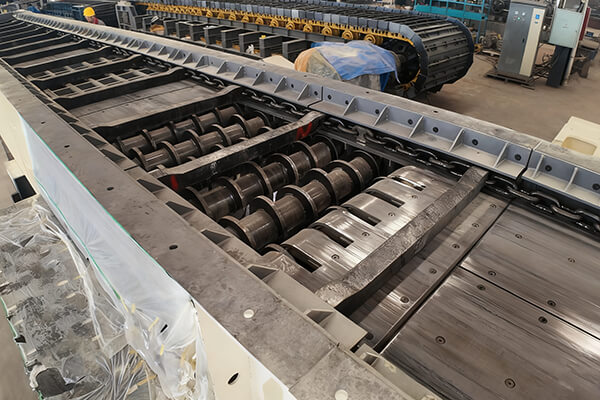
Feeder Breaker with Pre-screening
Strip screening (static screening)
Execution component
The core execution component is the scraper conveyor strip screening box body. The key structure of this box lies in the multiple guide rails laid on the connecting beam, which are closely arranged to form a unique "strip gap" structure, which is the core for achieving the screening function.
Working principle
The materials first enter from the tail of the feeder breaker and then fall onto the scraper chain of the mesh screening box section. As the scraper chain continuously moves, the materials are driven along the chain and undergo a continuous rolling and flattening process. During this process, the finest particles with a size smaller than the mesh gap, such as powder and small particles, can, under the influence of gravity, pass through these meticulously designed meshes immediately and fall down, thus completing the initial screening process.
Functional advantages
The discharge end usually has a specific opening or channel, whose size and shape are carefully designed. It can not only ensure that the crushed and qualified materials pass smoothly, but also prevent non-crushable objects from blocking during the discharge process. For non-crushable objects, due to their large volume and hardness, the powerful conveying capacity of the chain can smoothly push them to the discharge end, allowing them to be discharged together with the crushed and qualified materials outside the equipment. This discharge method not only improves the processing efficiency of the equipment, but also avoids the accumulation of non-crushable objects inside the equipment, which could cause damage to the equipment, ensuring the stable operation of the Feeder Breaker.
Roller screening (dynamic screening)
Execution components
Mainly include scraper conveyors and roller screening. The core part consists of the first roller and the second roller driven by an electric motor and continuously rotating. These two rollers are arranged in an intersecting manner to ensure that the materials can be fully processed during the screening process. This not only improves the processing efficiency of the materials but also enhances the overall stability of the feeder breaker.
Working principle
Firstly, after the materials pass through the first stage of screening, the remaining portion will be smoothly transported by the scraper conveyor to the roller screen section. Here, the rotating rollers play a dual role: on the one hand, they continue to transport the materials forward to ensure the continuity of the screening process; on the other hand, the dynamic gap between the rollers performs a more precise secondary screening on the materials. Specifically, the medium-sized particle materials with a size smaller than the roller gap will fall from the gap during the rotation of the rollers, achieving effective separation. Moreover, the rotating action of the rollers not only has a conveying function but also has agitating and crushing effects. For those slightly adhered materials, the rotation of the rollers can effectively disperse them, helping the particles that meet the requirements to be separated smoothly, further improving the screening effect.
Functional advantages
The design of rotating rollers can effectively prevent wet and sticky materials from blocking during the screening process, thereby greatly improving the efficiency of screening. Secondly, this equipment also has a crushing function. For those small pieces of materials or brittle materials, the rotation of the rollers can produce a certain crushing effect, which not only reduces the workload of the feeder breaker crushing module but also further enhances the overall efficiency of the material processing system.
The advantages of the Feeder Breaker compared to traditional equipment
Smaller space occupation
The traditional system requires installing a feeding equipment first, and then connecting it to an independent crushing equipment through a chute or short belt, which requires a larger site, more complex foundation construction and supporting structures.
The Feeder Breaker integrates the feeding and crushing functions in a compact unit, usually directly installed below the silo or chute, with a more compact length and height, significantly reducing the amount of foundation work and lowering the initial investment cost, especially suitable for underground mines and other environments with limited space.
Lower operating costs
The traditional system requires separately configuring independent motors, reducers, control systems and power supply lines for the feeder and the crusher, resulting in a large number of equipment and high initial investment.
The Feeder Breaker as an integrated device usually only requires one set of drive system (or main drive + crusher drive), reducing the number of motors and electrical controls, not only lowering the procurement cost but also reducing subsequent maintenance points and power consumption.
Discharge particle size
If the feeding at the front of the traditional system is uneven or the performance of the crusher fluctuates, it may cause the discharge particle size to be unstable and fluctuate.
The Feeder Breaker as a buffering and regulating unit can accept the impact feeding from the loader or truck, and through the uniform movement of the chain plate, ensure a stable and controllable flow to supply materials to the downstream belt conveyor. At the same time, its crushing function ensures that the discharge particle size is limited below the gap of the screen bars or the set size of the crusher, effectively preventing large pieces of materials from damaging or scratching the downstream conveyor belt.
Conclusion
The chain conveying part of the Feeder Breaker achieves stable operation throughout the entire process of material feeding, loading, uniform transportation to the crushing chamber through the coordinated action of components such as the driving device, heavy-duty chains, scrapers and troughs.



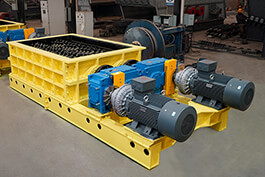

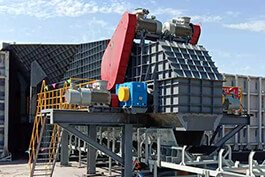
.jpg)
